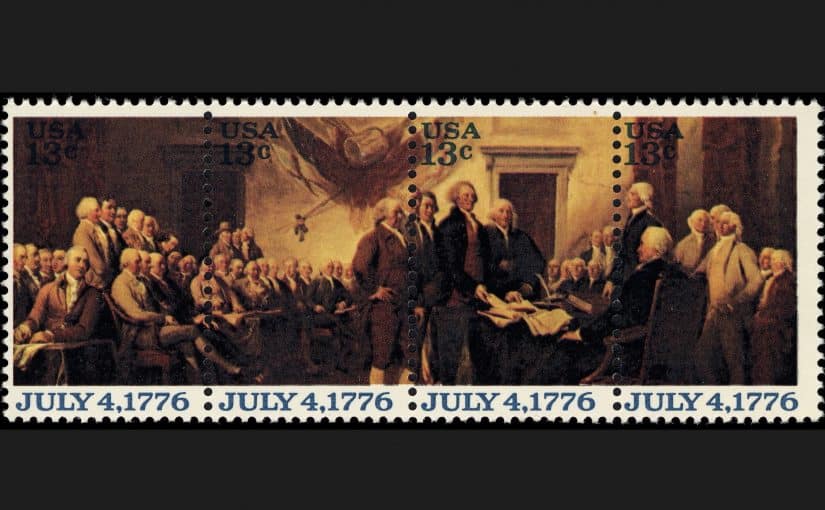Principles of Liberty: Ten Biblical Truths Embedded in the Declaration of Independence
A Five-Session Bible Study
Teaching Plan for Session 2
The Relationship of God’s Laws to Human Happiness and Human Worth
In this series of Bible studies, we are exploring ten Christian elements in the Declaration of Independence, ten ideals that are thoroughly biblical but not always recognized as such in our day. In fact, modern non-Christian influences have so redefined and reinterpreted words and concepts that in some cases, contemporary Americans completely misunderstand what the Founders intended. A Word Foundations article titled “Principles of Liberty” is foundational to this series.

A PDF file of the above graphic is available here.
It’s high time we rediscover the true meaning of these principles and that we contend anew for them as the Founders understood them. In our study, we are highlighting words and phrases from the most quoted portion of the Declaration, then we’re demonstrating how they’re linked to Scripture and to biblical truth. In each session we’re considering two principles.
Here are the principles we are examining in Session 2.
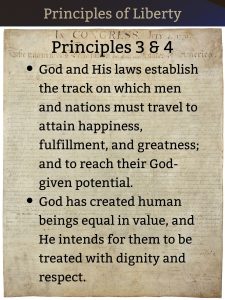
A PDF file of the above graphic is available here.
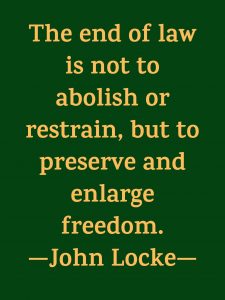 Read the background information for the session. Be aware it provides a good bit more information than you will use in the session.
Read the background information for the session. Be aware it provides a good bit more information than you will use in the session.- Review Principles 1 & 2. Display Principles 3 & 4. Read Principle 3: God and His laws establish the track on which men and nations must travel to attain happiness, fulfillment, and greatness; and to reach their God-given potential.
- Explain that John Locke was from England and lived from 1632 to 1704. He was an Enlightenment thinker whose work influenced the Founders, but he cannot be considered a purely secular philosopher. Share this quote from Locke: “The end of law is not to abolish or restrain, but to preserve and enlarge freedom.” A PDF file of this graphic is available here.
- Ask: What do you think Locke meant by this statement? Could he have meant that when properly applied, a just law liberates more than it restrains? How is this possible?
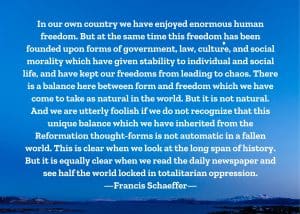 Share that in his last book, The Great Evangelical Disaster (1984), Francis Schaeffer wrote of the balance between form and freedom that must occur in all free societies. He said, “In our own country we have enjoyed enormous human freedom. But at the same time this freedom has been founded upon forms of government, law, culture, and social morality which have given stability to individual and social life, and have kept our freedoms from leading to chaos. There is a balance here between form and freedom which we have come to take as natural in the world. But it is not natural. And we are utterly foolish if we do not recognize that this unique balance which we have inherited from the Reformation thought-forms is not automatic in a fallen world. This is clear when we look at the long span of history. But it is equally clear when we read the daily newspaper and see half the world locked in totalitarian oppression.”1 Where do we find the right balance between order and liberty, or, in Schaeffer’s words, the proper balance between “form and freedom” that is so essential in free societies and in free market economies? The answer is clear. We find it in God’s Word. History testifies that America’s founders, as well as until recently her leaders, have upheld this balance as essential. A PDF file of the above graphic is available here.
Share that in his last book, The Great Evangelical Disaster (1984), Francis Schaeffer wrote of the balance between form and freedom that must occur in all free societies. He said, “In our own country we have enjoyed enormous human freedom. But at the same time this freedom has been founded upon forms of government, law, culture, and social morality which have given stability to individual and social life, and have kept our freedoms from leading to chaos. There is a balance here between form and freedom which we have come to take as natural in the world. But it is not natural. And we are utterly foolish if we do not recognize that this unique balance which we have inherited from the Reformation thought-forms is not automatic in a fallen world. This is clear when we look at the long span of history. But it is equally clear when we read the daily newspaper and see half the world locked in totalitarian oppression.”1 Where do we find the right balance between order and liberty, or, in Schaeffer’s words, the proper balance between “form and freedom” that is so essential in free societies and in free market economies? The answer is clear. We find it in God’s Word. History testifies that America’s founders, as well as until recently her leaders, have upheld this balance as essential. A PDF file of the above graphic is available here.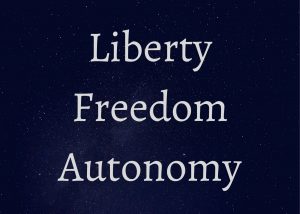 Discuss the similarities and differences between definitions of the terms Liberty, Freedom, and Autonomy. Also discuss the connotations they carry. Go here 1) for digital cards displaying these words and 2) for definitions from Noah Webster’s 1828 dictionary. A PDF file of this graphic is available here.
Discuss the similarities and differences between definitions of the terms Liberty, Freedom, and Autonomy. Also discuss the connotations they carry. Go here 1) for digital cards displaying these words and 2) for definitions from Noah Webster’s 1828 dictionary. A PDF file of this graphic is available here.- Summarize the definitions of the terms you discussed in item 6 by saying that Liberty and Freedom are are compatible with ordered societies that recognize personal choices and rights, but raw Autonomy is not. Because unrefined Autonomy is freedom without restraint, liberty and freedom cannot coexist with widespread autonomy in the long run.
- Say: Today, people are trading away liberty and authentic freedom for autonomy. They don’t recognize the difference. As more and more people do this, society will lose cohesiveness and structure, and it will unravel. Eventually, order no longer will be possible without external force, because internal restraints no longer will exist. Liberties will be lost. We have seen some of this already with the looting and riots in the wake of George Floyd’s tragic death.
- Elaborate: In a free society, people police themselves. In a society where people confuse liberty and autonomy, the government can’t hire enough law enforcement officers. This is especially true if it disrespects all of them, even those who do their jobs well.
- Explain that this is why respect for God and God’s laws is so important—and it is why the Founders wrote respectfully of God and His laws and acknowledged them in the Declaration of Independence.
- From the background information for this session, share either “The Dachshund and the Hamster” or “The Crab.” Both are located on this page. Discuss the lessons highlighted by the one you selected and shared.
 Discuss the difference between the meaning of the word entitle as the Founders used it in the Declaration and the meaning typically employed when people use it and its various forms today. A PDF file of this graphic is available here.
Discuss the difference between the meaning of the word entitle as the Founders used it in the Declaration and the meaning typically employed when people use it and its various forms today. A PDF file of this graphic is available here.- Ask participants to turn in their Bibles to Luke 15:11-32, where Jesus told the parable of the prodigal or lost son. Discuss this parable in relation to the themes you’ve explored thus far in this study, including liberty, freedom, autonomy, and being entitled versus feeling entitled. In addition, you may wish briefly to highlight a few other themes, such as authority and responsibility.
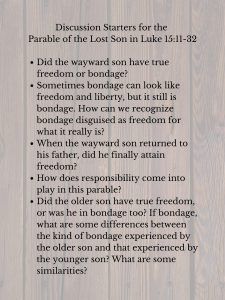 Here are some questions and insights that might prompt some good discussion: • Did the wayward son have true freedom or bondage? • Sometimes bondage can look like freedom and liberty, but it still is bondage. How can we recognize bondage disguised as freedom for what it really is? • When the wayward son returned to his father, did he finally attain freedom? • How does responsibility come into play in this parable? • Did the older son have true freedom, or was he in bondage too? If bondage, what are some differences between the kind of bondage experienced by the older son and that experienced by the younger son? What are some similarities? A PDF file of the above graphic is available here.
Here are some questions and insights that might prompt some good discussion: • Did the wayward son have true freedom or bondage? • Sometimes bondage can look like freedom and liberty, but it still is bondage. How can we recognize bondage disguised as freedom for what it really is? • When the wayward son returned to his father, did he finally attain freedom? • How does responsibility come into play in this parable? • Did the older son have true freedom, or was he in bondage too? If bondage, what are some differences between the kind of bondage experienced by the older son and that experienced by the younger son? What are some similarities? A PDF file of the above graphic is available here.- Emphasize that true freedom and authentic liberty are enjoyed most fully in the context of a right relationship with the Father, or the Lord God. This is true not only for individuals, but for nations as well. Psalm 33:12 says, “Blessed is the nation whose God is the Lord, The people He has chosen as His own inheritance.” Proverbs 14:34 declares, “Righteousness exalts a nation, But sin is a reproach to any people.“
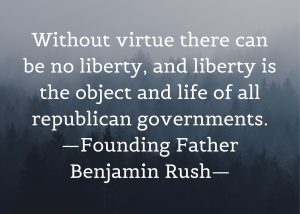 If desired and if time allows, read and briefly discuss Deuteronomy 30:11-20. Discuss how, in light of this passage, the Founders of America essentially chose life for the nation they were establishing and, to the degree that they could, set the new nation on a course consistent with God’s will and God’s laws. As an alternative, read and discuss Deuteronomy 8:1-20 and the warning it contains. Talk about how, even though God gave this warning to His people Israel, the warning has application for other nations as well. Thankfully, America’s Founders (and their fellow Americans) heeded that warning. This is not to say that all the Founders were Christians, but many were. Moreover, virtually all of them held to a biblical worldview.
If desired and if time allows, read and briefly discuss Deuteronomy 30:11-20. Discuss how, in light of this passage, the Founders of America essentially chose life for the nation they were establishing and, to the degree that they could, set the new nation on a course consistent with God’s will and God’s laws. As an alternative, read and discuss Deuteronomy 8:1-20 and the warning it contains. Talk about how, even though God gave this warning to His people Israel, the warning has application for other nations as well. Thankfully, America’s Founders (and their fellow Americans) heeded that warning. This is not to say that all the Founders were Christians, but many were. Moreover, virtually all of them held to a biblical worldview.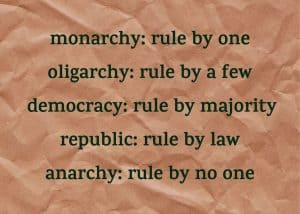 Emphasize this quote from Founding Father Benjamin Rush (1746-1814), a signer of the Declaration of Independence: “Without virtue there can be no liberty, and liberty is the object and life of all republican governments.” Explain that “republican governments” (with a lowercase r) are governments or societies ruled by law, not the majority (democracy), not a few (oligarchy), not one (monarchy), and not no one (anarchy). A PDF file of the above graphic is available here. A PDF file of the Benjamin Rush quote is available here.
Emphasize this quote from Founding Father Benjamin Rush (1746-1814), a signer of the Declaration of Independence: “Without virtue there can be no liberty, and liberty is the object and life of all republican governments.” Explain that “republican governments” (with a lowercase r) are governments or societies ruled by law, not the majority (democracy), not a few (oligarchy), not one (monarchy), and not no one (anarchy). A PDF file of the above graphic is available here. A PDF file of the Benjamin Rush quote is available here.- Direct participants’ attention to Principle 4: God has created human beings equal in value, and He intends for them to be treated with dignity and respect. Emphasize that this principle is reflected in these words in the Declaration: “We hold these truths to be self-evident, that all men are created equal, that they are endowed by their Creator with certain unalienable Rights, that among these are Life, Liberty and the pursuit of Happiness.” The words created equal are especially significant.
- State that people inevitably will ask, “How could the Founders say this and still allow the institution and the practice of slavery to continue?” Of course, this is an important question. Yet to receive an adequate answer, we need not just information, but an understanding of the culture and the times. Part of the reason people don’t fully understand the actions of the Founders today is that history has been misrepresented. People with contemporary political agendas distort what happened to gain and maintain their own power and influence over others.
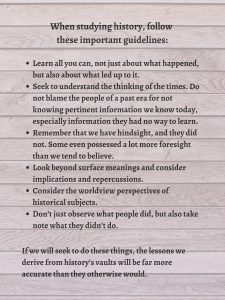 If time allows, review these guidelines for studying history. Tell participants the guidelines are available online at this address. Point out that the Founders were born into an era during which slavery was a part of the fabric of life, pretty much everywhere. A PDF file of this graphic is available here.
If time allows, review these guidelines for studying history. Tell participants the guidelines are available online at this address. Point out that the Founders were born into an era during which slavery was a part of the fabric of life, pretty much everywhere. A PDF file of this graphic is available here.- If desired, use this illustration (involving the Lewis and Clark Expedition) to demonstrate how absurd some distortions of historical events actually are. Emphasize, however, that typically the distortions are subtle and hard to detect.
- Such is the case with regard to the often-leveled accusation that the Founding Fathers were racists. The Three-Fifths Clause of the Constitution of 1787 usually is mentioned as evidence. The Three-Fifths Clause, however, is widely misunderstood.
- Share this PragerU video with participants to help them understand that the Founders are not getting a fair shake! (The video also is available here.)
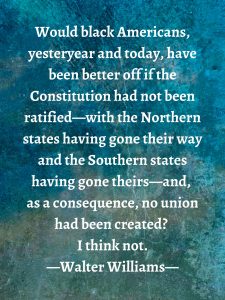 Professor Walter Williams, himself black, would agree with Carol Swain. He wrote, “A question that we might ask those academic hustlers who use slavery to attack and criticize the legitimacy of our founding is: Would black Americans, yesteryear and today, have been better off if the Constitution had not been ratified—with the Northern states having gone their way and the Southern states having gone theirs—and, as a consequence, no union had been created? I think not.” A PDF file of this graphic is available here.
Professor Walter Williams, himself black, would agree with Carol Swain. He wrote, “A question that we might ask those academic hustlers who use slavery to attack and criticize the legitimacy of our founding is: Would black Americans, yesteryear and today, have been better off if the Constitution had not been ratified—with the Northern states having gone their way and the Southern states having gone theirs—and, as a consequence, no union had been created? I think not.” A PDF file of this graphic is available here.- Even though it would be almost a century before slavery would be eliminated, the Founders pointed the nation in that direction by affirming that “all men are created equal.”
- Share this from background information for this session: “John Jay (1745-1829) became the first Chief Justice of the Supreme Court. He observed that before the American Revolution and the establishment of a stable government for the independent states, very little had been done to pry the institution of slavery from American life.”
- Ask volunteers to read the following passages: Genesis 1:26-28; Matthew 20:25-28; James 2:8-9; and Colossians 3:8-11. Briefly discuss how each relates to the ideals that all people 1) have been created by God and therefore 2) are of equal worth and 3) should be treated with dignity and respect.
- Read 2 Corinthians 5:16a from the New International Version (NIV): “So from now on we regard no one from a worldly point of view.” Say: Fortunately for all Americans and for the world, the Founders enshrined the ideal that all people are of equal worth in the founding document of the new nation. This action has had far-reaching positive repercussions ever since.
- Explain that even though it would increase, the initial anti-slavery impact of Declaration of Independence was both profound and immediate. William Whipple, a signer of the Declaration from New Hampshire, “freed his slave” because he believed “that he could not both fight for liberty and own a slave.” Some believe the same man William Whipple freed, Prince Whipple, is depicted in Emanuel Leutze’s immortal 1851 painting Washington Crossing the Delaware. A black gentleman is shown in the lower left portion of the painting, rowing and seated near Washington’s right knee (see portrait below).
- State that even slave owners had their consciences stirred during the Revolutionary era. James Madison, a Founding Father and a slaveholder, conveyed the following in a letter to his father. He obviously was troubled about the institution of slavery as he explained he would have to sell the slave who had been accompanying him. Madison wrote, “I do not expect to get near the worth of him; but cannot think of punishing him by transportation merely for coveting that liberty for which we have paid the price of so much blood, and have proclaimed so often to be the right, & worthy the pursuit, of every human being.”
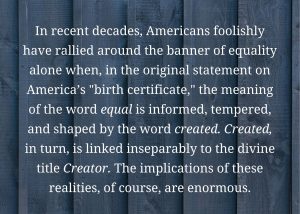 Conclude with this warning from the main article: “In recent decades, Americans foolishly have rallied around the banner of equality alone when, in the original statement on America’s ‘birth certificate,’ the meaning of the word equal is informed, tempered, and shaped by the word created. Created, in turn, is linked inseparably to the divine title Creator.…The equality among men that Jefferson, the Committee of Five, and the Second Continental Congress promoted and upheld is not one achieved through societal manipulation or government intervention, but one that already exists. It is an equality government has a duty to recognize and protect, a God-given attribute in which unalienable rights are deeply rooted and in which they find their sustenance. We have ignored this point to our own peril, and we must rediscover it and appreciate it once again.” In our next session, we will explore the theme of equality more thoroughly. A PDF file of the above graphic is available here.
Conclude with this warning from the main article: “In recent decades, Americans foolishly have rallied around the banner of equality alone when, in the original statement on America’s ‘birth certificate,’ the meaning of the word equal is informed, tempered, and shaped by the word created. Created, in turn, is linked inseparably to the divine title Creator.…The equality among men that Jefferson, the Committee of Five, and the Second Continental Congress promoted and upheld is not one achieved through societal manipulation or government intervention, but one that already exists. It is an equality government has a duty to recognize and protect, a God-given attribute in which unalienable rights are deeply rooted and in which they find their sustenance. We have ignored this point to our own peril, and we must rediscover it and appreciate it once again.” In our next session, we will explore the theme of equality more thoroughly. A PDF file of the above graphic is available here.
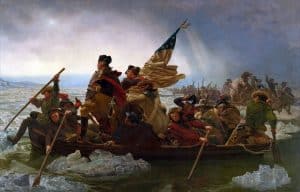
Let’s Review: Here are the principles we have highlighted during this session. These are the third and fourth items on our list. • 3) God and His laws establish the track on which men and nations must travel to attain happiness, fulfillment, and greatness; and to reach their God-given potential. • 4) God has created human beings equal in value, and He intends for them to be treated with dignity and respect.
Looking ahead: Share with participants that next time, you will examine the fifth and sixth principles on the list. A PDF file of this graphic is available here.
-
-
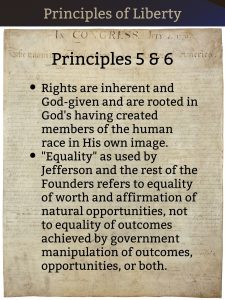 Rights are inherent and God-given and are rooted in God’s having created members of the human race in His own image.
Rights are inherent and God-given and are rooted in God’s having created members of the human race in His own image.- “Equality” as used by Jefferson and the rest of the Founders refers to equality of worth and affirmation of natural opportunities, not to equality of outcomes achieved by government manipulation of outcomes, opportunities, or both.
-
Assignment: Ask participants to visit the Word Foundations website at www.wordfoundations.com. Remind them: On the menu on the left, the 3 items listed right above the Subscribe boxes are
-
-
- “The Bible and Free Enterprise, Part 1,”
- “The Bible and Free Enterprise, Part 2,” and
- “The Bible and Free Enterprise, Part 3.”
-
Ask participants to visit the site and to click on Part 2 and read it for next time. If needed, remind them that the free enterprise system rests on the freedoms the Founders upheld in the Declaration. We need to learn how the principles of a free market economic model align with biblical truth. (You can access all the articles in this series from this page.)
Close in prayer. Thank God that the Founders of America understood the importance of God’s laws in securing and maintaining liberty, and that they affirmed the equal and infinite worth of all people. Thank the Lord as well for the benefits that have flowed from these perspectives, and pray that people today will understand anew the true source of all those benefits.
Copyright © 2020 by B. Nathaniel Sullivan. All rights reserved.
Unless otherwise indicated, Scripture has been taken from the New King James Version®. Copyright © 1982 by Thomas Nelson, Inc. Used by permission. All rights reserved.
The Scripture reference marked NIV has been taken from The Holy Bible, New International Version®, NIV® Copyright © 1973, 1978, 1984, 2011 by Biblica, Inc.® Used by permission. All rights reserved worldwide.
Note:
1Francis Schaeffer, The Great Evangelical Disaster, (Westchester, IL: Crossway Books, 1984), 21-22.
